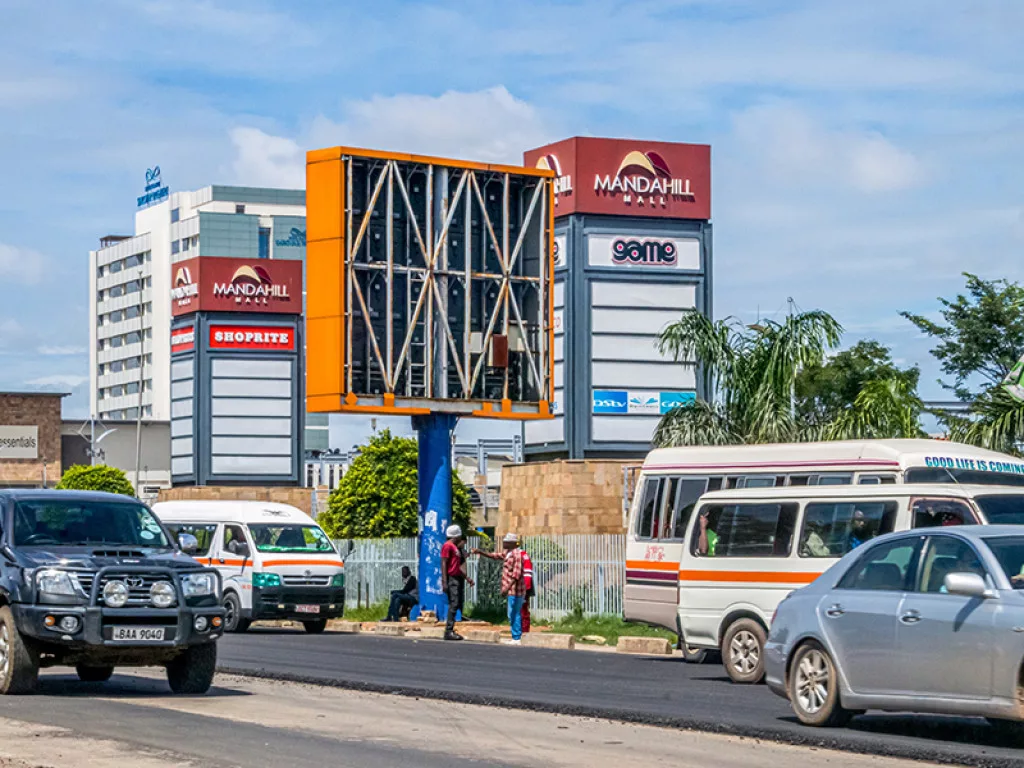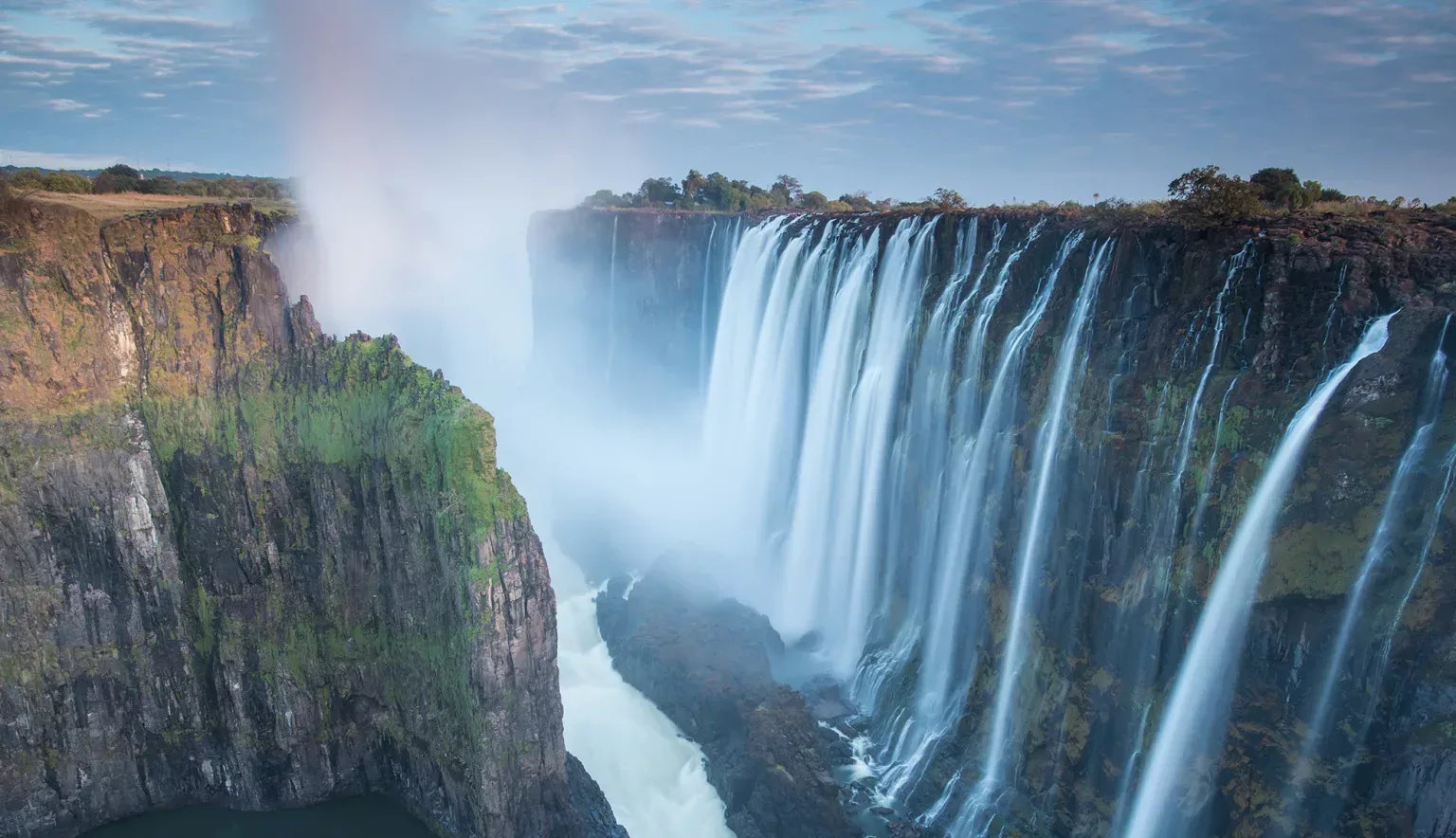Waterfalls and wildebeests; the spirit of African adventure flows through Zambia, a must-see place to visit.
ZAMBIA
To visitors from around the world, Zambia embodies the classic African experience; fiery sunsets over rolling grasslands silhouetted by the sparse and iconic acacia trees; herds of elephants and lion prides dwelling by watering holes; verdant forests teeming with ever-changing life; rivers and wetlands where hippos live and thrive, all set close to the belly of the continent.
Zambia is widely regarded as one of Africa’s top destinations for travel, and it is clear to see why. The country is blessed with a rich and diverse geography that is matched by that of its cultural heritage and is home to majestic natural wonders such as Mosi-oa-Tunya – “The Smoke That Thunders” – also known as Victoria Falls.
The Devil’s Pool looks out over this monumental drop – the best seat in the house. Visitors can immerse themselves in shallow pristine waters that have travelled hundreds of miles via the Zambezi River, and witness refracting rainbows born from the sun’s touch on cascading vapours.
Beyond Zambia’s natural beauty, the bustling capital of Lusaka boasts restaurants offering dishes and dining experiences unique to the country, active and energetic nightlife, and a range of markets where tourists can purchase goods that are cultural staples in the region.
With Zambia’s dry season taking precedence over half of the year, all of this is within reach for the awe-inspired and adventurous traveller, and it remains a must-do on the African travel bucket list.
TOURISM INSIGHTS: ZAMBIA TOURISM AGENCY
Operating in a country of boundless wonder, we take a look at Zambia Tourism Agency, the organisation’s efforts in promoting the rich and diverse nation, while also covering its response to the COVID-19 pandemic and plans for the future of tourism.
Q&A WITH CHAVUNGA LUNGU, ACTING CHIEF EXECUTIVE OFFICER, ZAMBIA TOURISM AGENCY
Can you talk me through the origins of Zambia Tourism Agency and its initial vision?
Chavunga Lungu, Acting Chief Executive Officer (CL): The Zambia Tourism Agency (ZTA), formerly Zambia Tourism Board (ZTB), was established through the Tourism and Hospitality Act. No. 13 of 2015. Through this, ZTA is mandated to “effectively market Zambia as a tourist destination of choice” and to “regulate the tourism industry”.
The sole mandate of ZTB was to market Zambia’s tourism products locally and internationally. The regulatory function was reposed in the ministry responsible for tourism. This meant that the institution responsible for the marketing of tourism was delinked from the enforcement of standards in the hospitality industry.
The new Act of 2015 empowered ZTA to regulate the tourism industry through licensing tourism enterprises, setting standards and carrying out inspections to ensure conformity to the minimum set standards. These functions are in addition to the responsibilities of ZTB which were purely marketing oriented.
ZTA is anchored on the vision of becoming a leading tourism marketing agency in Africa by 2030. This desire has been the focal point for all ZTA destination marketing collateral, with enhanced social media marketing activities to raise awareness, especially for the international markets.
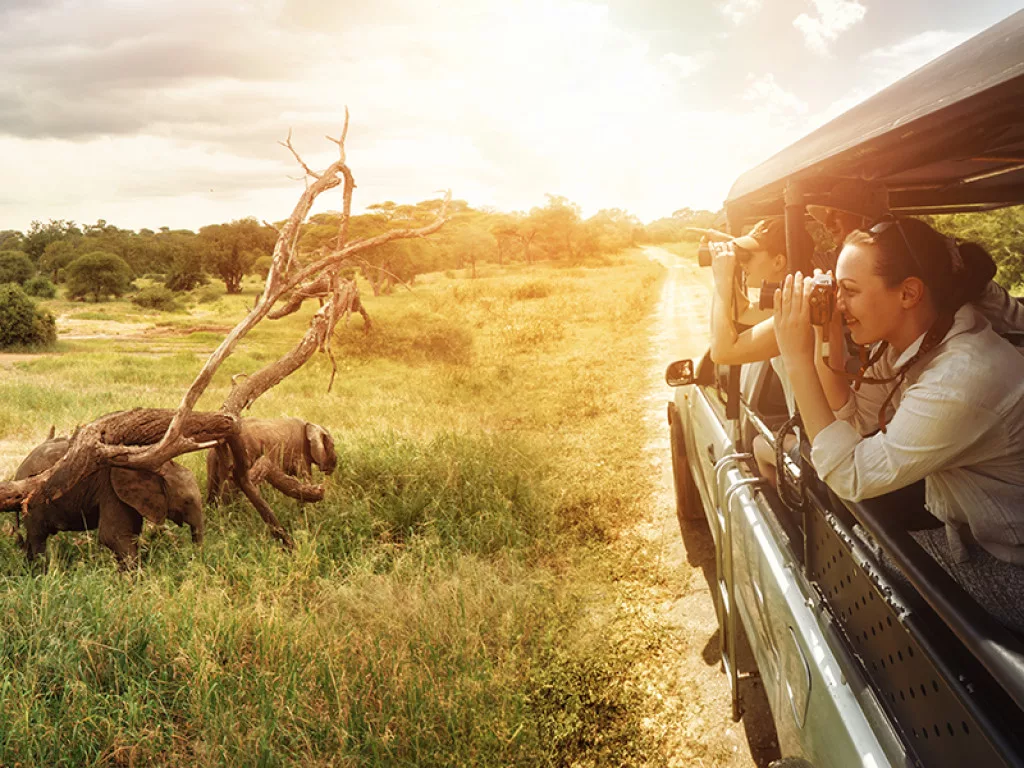
What are your organisation’s current goals?
(CL): ZTA will continue to target tourists from markets with high volumes of travel, whilst also offering attractive tourism products such as exclusive safari experiences. ZTA will leverage on enhanced visitor satisfaction, improved tourism economy and the sustainable use of tourism resources.
Further, ZTA will also focus on the following strategies:
- Diversify into relatively new but potential international leisure markets.
- Consolidate and penetrate Europe, the US and African leisure markets where ZTA already has strong tourism growth.
- Target meetings, incentives, conferences and events (MICE) as a new product for the African/regional and European markets.
- Stimulate the desire to travel locally by citizens and residents.
How do you market Zambia as both a business and leisure travel destination?
(CL): Zambia leverages its strategic position which has access to eight countries providing unparalleled land linkage as a business travel destination of choice. Zambia offers a professionally designed MICE travel experience both locally, regionally and globally. Over the last five years, the country has built a strong infrastructure to support the growing demand for business and leisure travel.
Zambia continues to have a strong presence on social media platforms, and through virtual interactions, ZTA has been able to host destination presentations to key source markets.
Zambia continues to engage with strategic partners, and recently the country participated in the Eurowings Germany Roadshow to promote African destinations in view of the newly launched routes into Southern Africa in 2022. The hosting of the African Union Mid-Year Meetings in July 2022 also positioned the country as an emerging conference hub not only in Africa, but the world at large.
A state-of-the-art conference facility, the Kenneth Kaunda wing of the Mulungushi International Conference Centre has been built in Zambia’s capital city of Lusaka, catering for huge meetings and conferences.
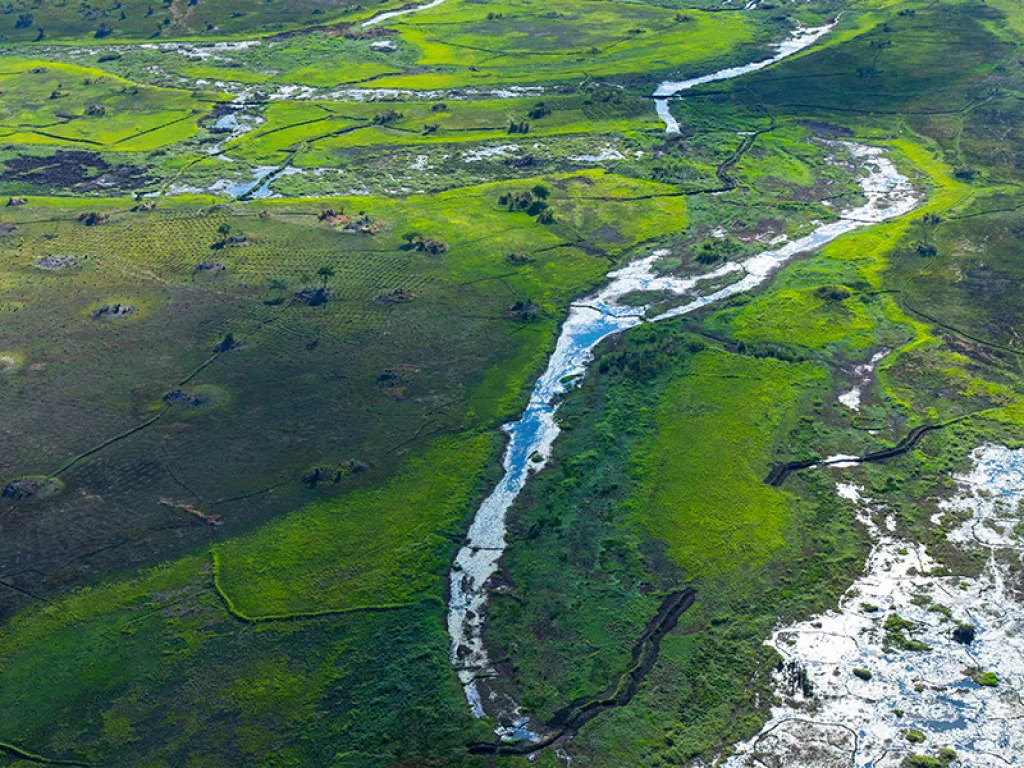
What trends are currently reshaping tourism in Zambia, and how are you utilising them?
(CL): Tourism is essentially integrated with other sectors in the economy, so tourism trends cannot be considered in isolation from key drivers that will shape the future. Natural resources and environment; science and technology; travellers’ desire for new experiences and other dynamics that range from destinations following the COVID-19 pandemic are some of the trends transforming the tourism industry in Zambia.
Zambia has seen a growing demand for leisure travel, especially from the middle class who tend to combine business travel with leisure, enjoying the leisure aspect with friends and relatives. ZTA has used social media to reshape tourism because of the impact that the social platform has on people’s lives, and has continued to engage the services of influencers to motivate future consumers of tourism by sharing varied experiences from different destinations.
This strategy has seen an increased number of people undertaking local travel and posting their experiences to international audiences, demonstrating the power of social media in tourism marketing.
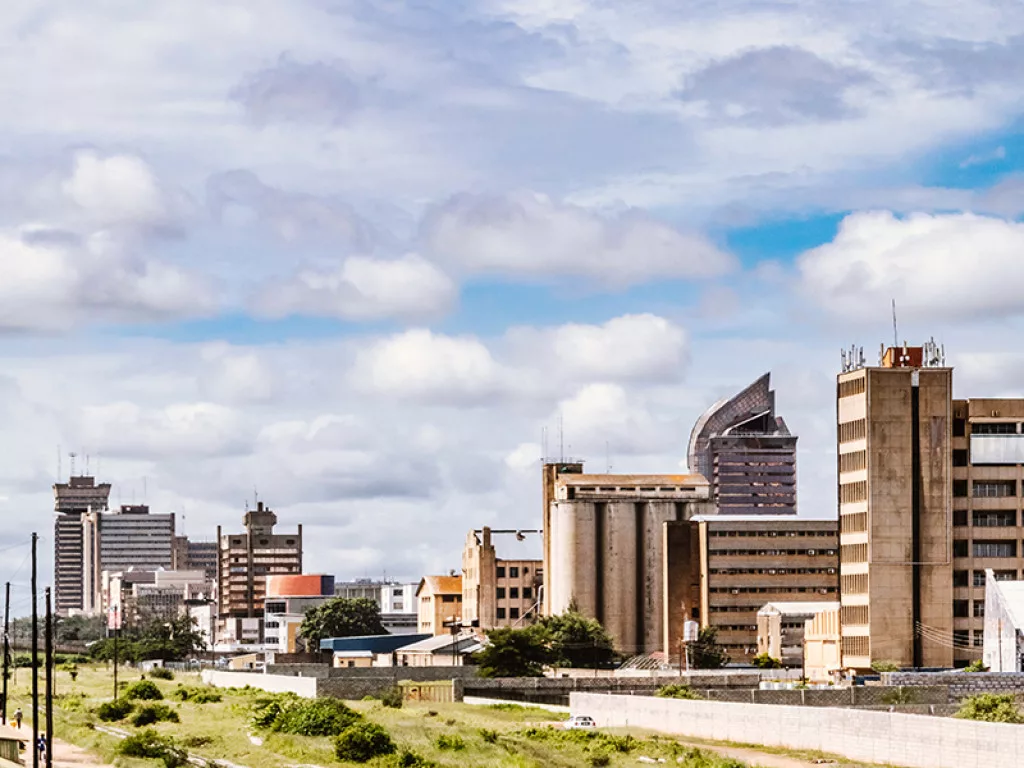
How is environmental sustainability transforming Zambia’s tourism industry?
(CL): Environmental sustainability has been a key element for Zambia’s competitive advantage. Zambia is home to the South Luangwa National Park, an international sustainable park, recognised by the United Nations World Tourism Organization (UNWTO) as a park that has taken full accountability for its current and future economic, social and environmental impacts, addressing the needs of visitors, the industry, the environment and host communities. Most of Zambia’s tourism players are implementing sustainable tourism practices that include, protecting the environment, natural resources and wildlife, providing socio-economic benefits for communities who live in tourist destinations, conserving cultural heritage, and creating authentic tourist experiences.
Are you optimistic about the future of the tourism industry in Zambia, particularly with regards to the COVID-19 pandemic?
(CL): Zambia remains optimistic about the future of tourism. The sector is a major driver of economic growth and a catalyst for job creation. The Zambian government has prioritised the industry as an economic sector. After years of growth and expansion in the sector, the COVID-19 pandemic has had a devastating impact on tourism enterprises, the livelihoods of tourism workers, and communities.
The pandemic and the subsequent restrictions placed on travel and tourism in order to slow the spread of the COVID-19 virus exposed the fragility of the sector and its vulnerability to shocks. Nonetheless, Zambia is rebounding, and future prospects look even brighter than before because of the desire of the international traveller to get out after the shocks of COVID-19. Zambia as a destination remained strong with regards to managing the threats of COVID-19 and the sector was on high alert to avert any challenges that the pandemic would have on the industry. ZTA will continue using a multi-sectoral approach to ensure that all stakeholders continue monitoring the trends and developments of the pandemic.
This year seems to have exceeded expectations, as early indications suggest that the forecasted rebound of the tourism sector has come sooner than was anticipated.
The COVID-19 pandemic brought transformation to many facets including marketing, bringing to life new ways of doing things or enhancing what already existed but was underutilised before the pandemic hit. Marketing Zambia after the pandemic, the tactics we are using are strongly anchored on digital media platforms. Digital platforms post-COVID-19 have enormous traction globally, presenting an easily accessible market within seconds of initiating interaction.
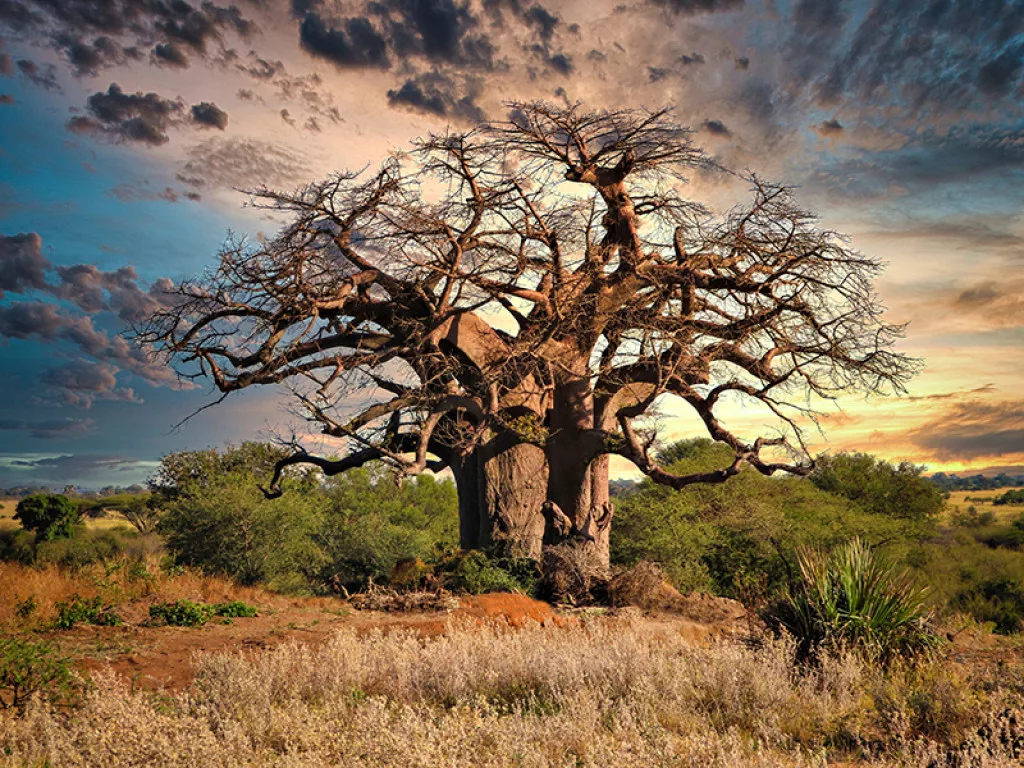
Finally, what are your priorities for the year ahead?
(CL): The tourism sector will remain an important component of our economy and allow us to create quality jobs for Zambians and great opportunities for our businesses to ensure the vitality and sustained growth of the industry. ZTA is putting in place a robust tourism marketing programme to incorporate all tourism products to include traditional ceremonies, visual arts, culture, heritage sites and more. Zambia will also promote tourism diversification to attract more and new visitors to our destination.
OUTLOOK RECOMMENDS
Sleep:
For luxury in Lusaka…
Eat:
FOR AUTHENTIC LOCAL FARE…
A taste of the country’s culture, try Zambian fish curry or free-range chicken with nshima.
Do:
FOR CLOSE ENCOUNTERS…
With friends or family, visit Kalimba Reptile Park.
For a solo or group activity…
Kayak down the powerful white waters of the Zambezi River below the falls.
For a Zambian experience like no other…
Walk with cheetas that are part of a national conservation programme at Mukuni Big 5 Safaris.
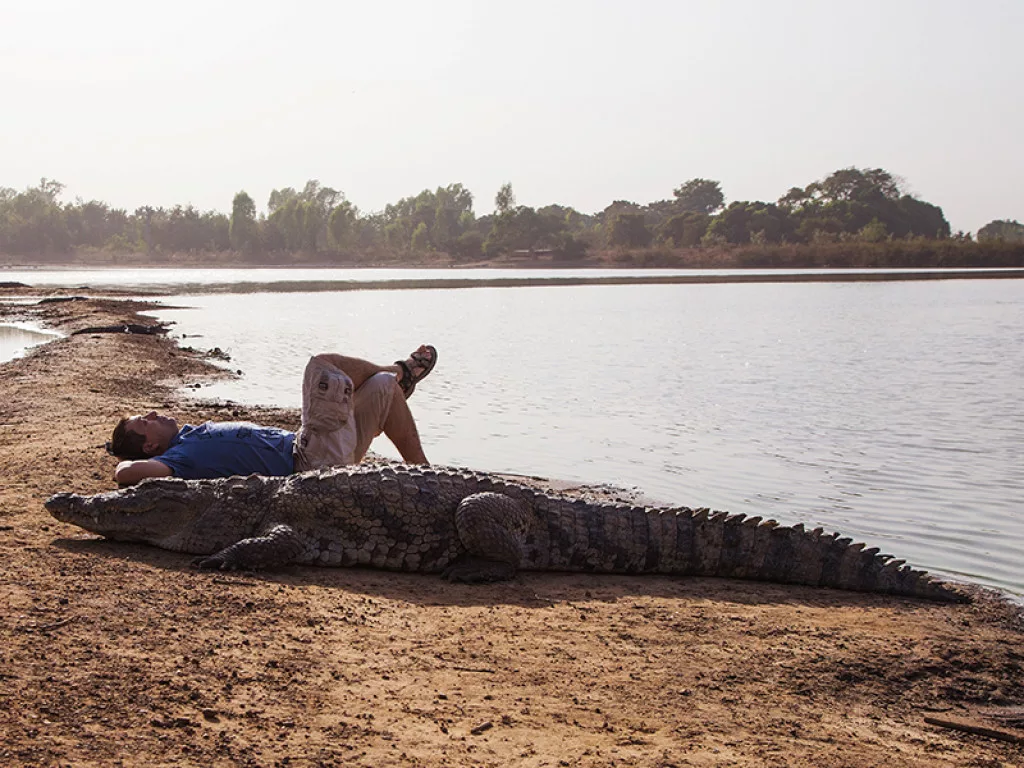
LOWER ZAMBEZI NATIONAL PARK IN FOCUS
This park is still relatively undeveloped; its beauty lies in its wild state. The diversity of animals is not as vast as the other larger parks, but the opportunities to get close to game wandering in and out of the Zambezi channels are spectacular. The park lies along the Zambezi River, a huge traction for wildlife so the whole area on both sides of the Zambezi River forms a massive wildlife sanctuary.
The river’s edge is overhung with a thick riverine fringe, including ebony and fig trees. Further inland is a floodplain bordered by mopane forest and interspersed with winter thorn trees and huge acacias. The hills which form the backdrop to the park are covered in broadleaf woodland.
Even though the Lower Zambezi National Park covers an area of 4,092 square kilometres, most of the game is concentrated along the valley floor. There is an escarpment along the northern end which acts as a physical barrier to most of the park’s animal species. Enormous herds of elephant, some up to 100 strong, are often seen at the river’s edge. ‘Island hopping’ buffalo and waterbuck are common. The park also hosts good populations of lions and leopards, and if you listen you may also be able to catch the piercing cry of the fish eagle.
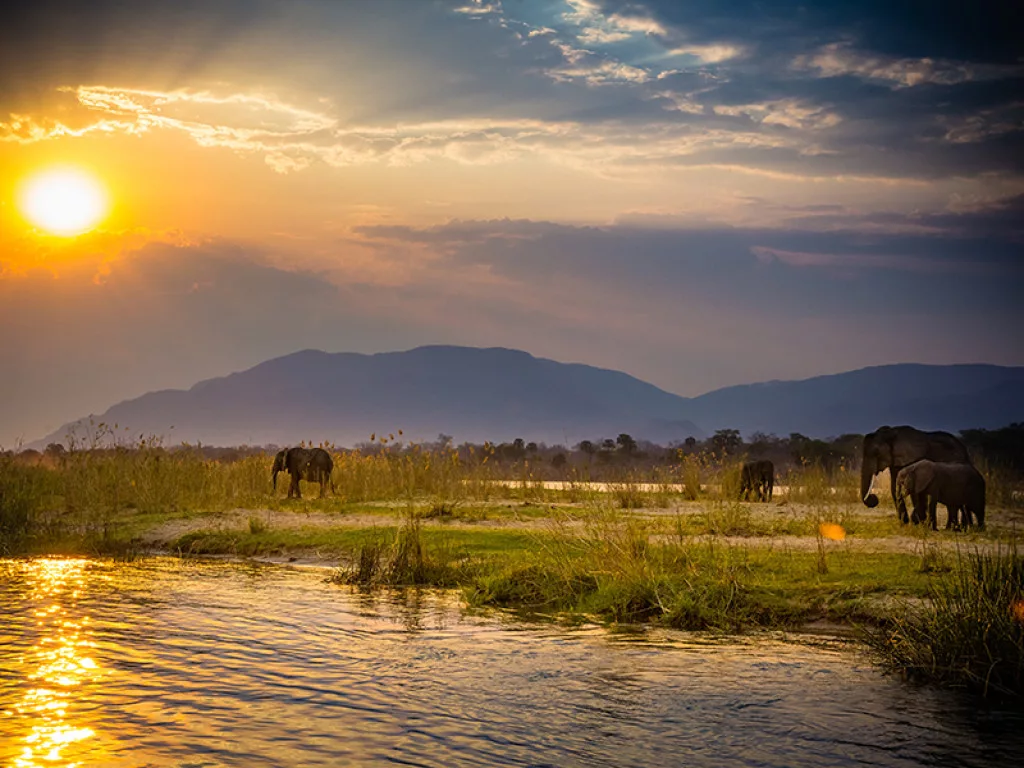
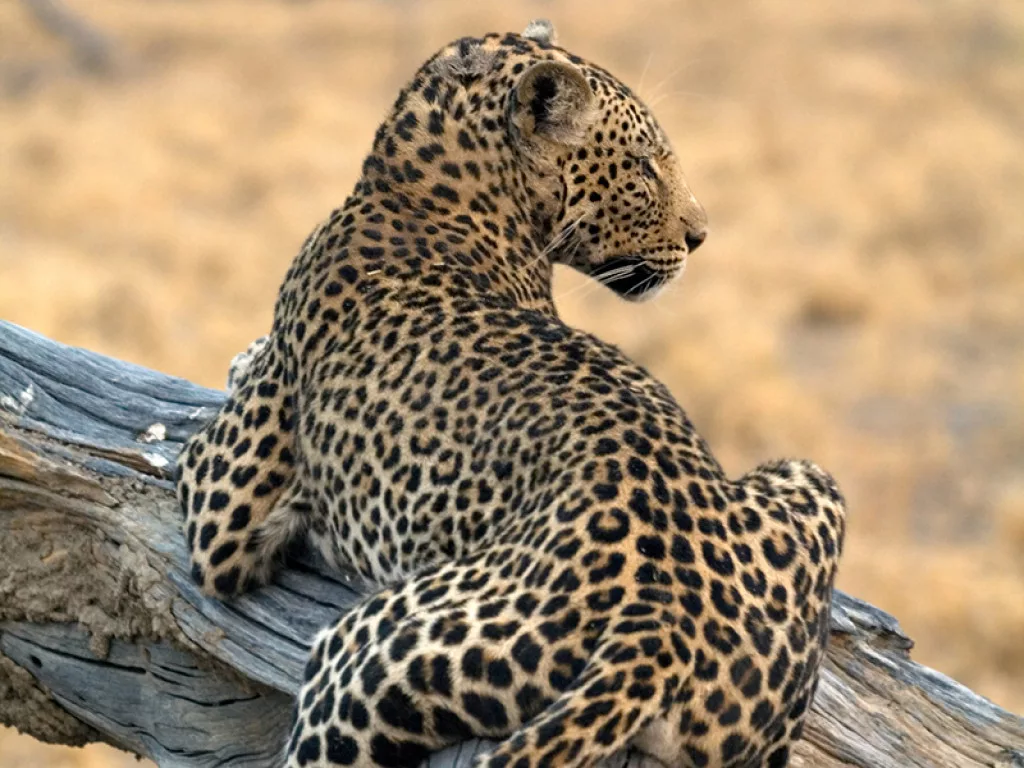
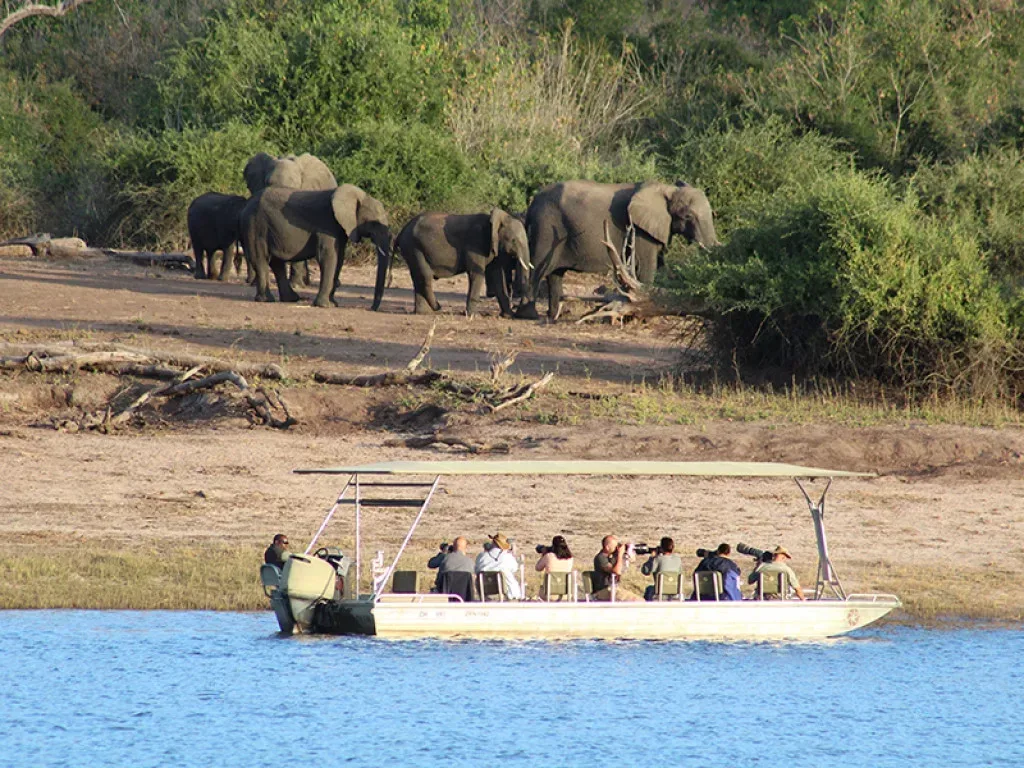
LANDMARK ATTRACTIONS
Victoria Falls
Victoria Falls presents a spectacular sight of awe-inspiring beauty and grandeur on the Zambezi River, forming the border between Zambia and Zimbabwe. It was described by the Kololo tribe living in the area in the 1800s as Mosi-oa-Tunya – ‘The Smoke that Thunders’. In more modern terms, Victoria Falls is known as the greatest curtain of falling water in the world. It is one of the seven natural wonders of the world and a UNESCO World Heritage Site.
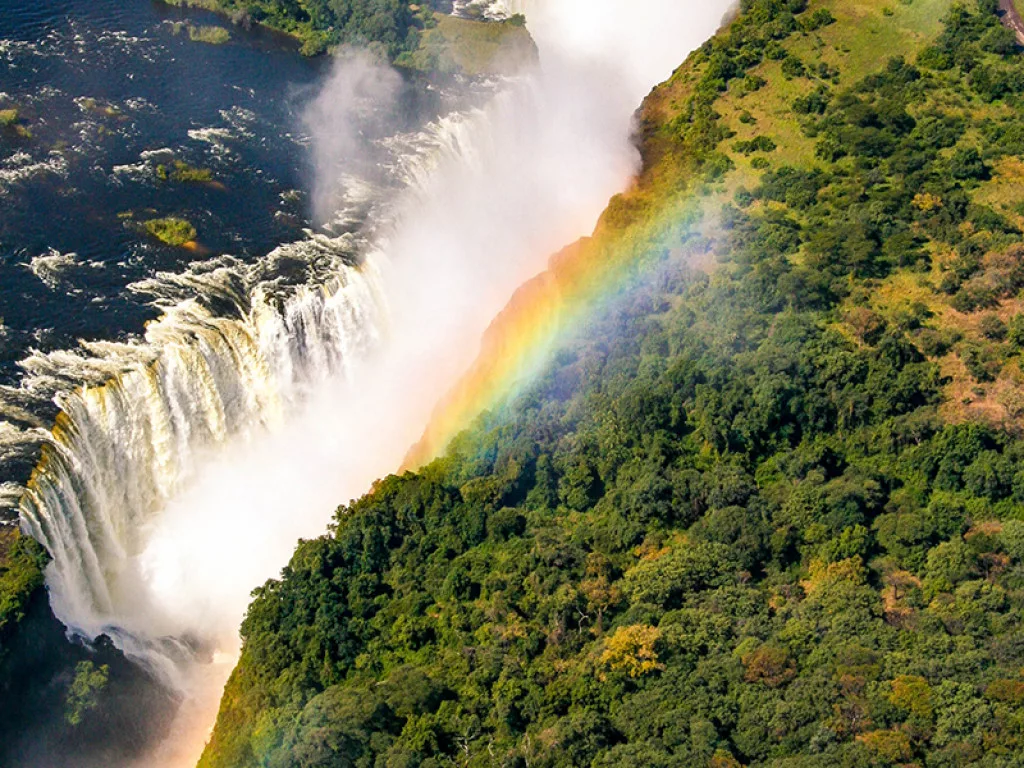
North Luangwa National Park
This remote tract of land, covering 4,636 square kilometres, offers one of the finest wilderness experiences in Zambia, if not Africa itself. It is open to the public and there are semi-permanent lodges there. Access the park with one of the few safari operators granted permission to conduct walking safaris.
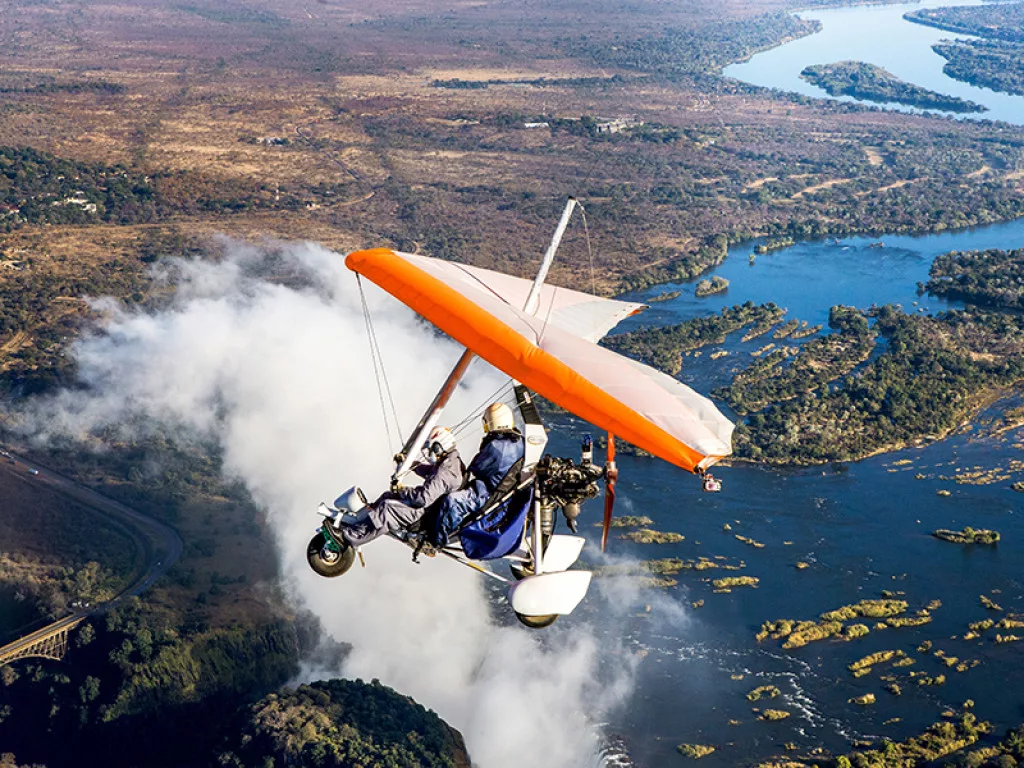
Simalaha Community Conservancy
Meaning “come together”, Simalaha is an apt name for the community conservancy inspired and driven by the Sesheke and Sekhute Chiefdoms. Bordering the Zambezi River on the Zambezi-Chobe Floodplain, Simalaha is where wildlife and people come together and co-exist under one sky as they once did many years ago. The Simalaha Conservancy is also a horse-riding uniquely destination found in the Kavango-Zambezi Conservation Area (KAZA).
GETTING THERE AND AROUND
Neighbouring eight countries and home to myriad waterways, travel to and from Zambia is best done via plane. The city of Lusaka is home to two airports, the Kenneth Kaunda International Airport (LUN) on the northwest outskirts serving international and commercial traffic, not to be mistaken with the second, centrally located Lusaka City Airport (FLLC) serving military and governmental traffic.
From the city, flights can take travellers to Mfuwe in South Luangwa, for walking safaris, elephant watching or alternative destinations to experience all Zambia has to offer.
Via road, there are long range buses that depart Lusaka to all main towns across the country, whilst minibuses or taxis are affordable options for shorter journeys. Alternatively, cars – or if you want local expertise, chauffer-driven vehicles – can be hired to explore urban hubs or various regions home to wildlife.

